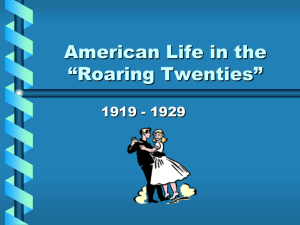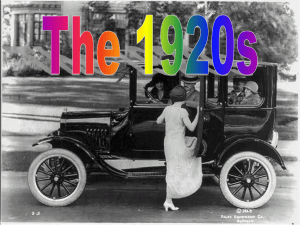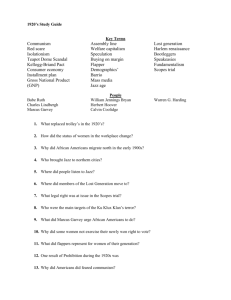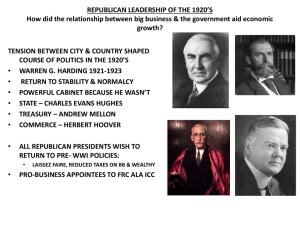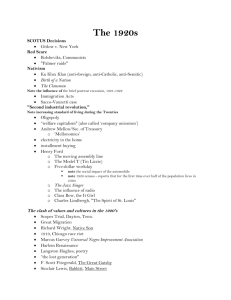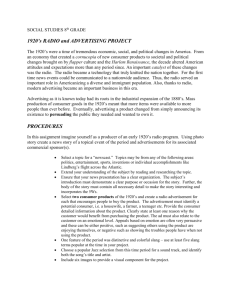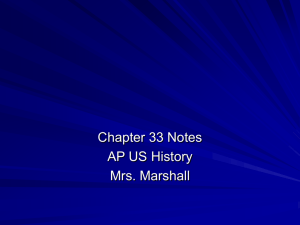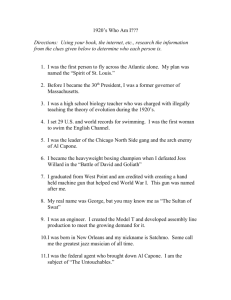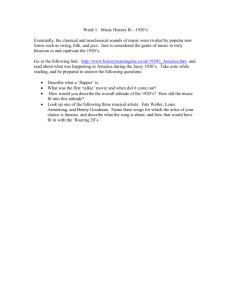23 RoaringTwenties - Kenston Local Schools
advertisement
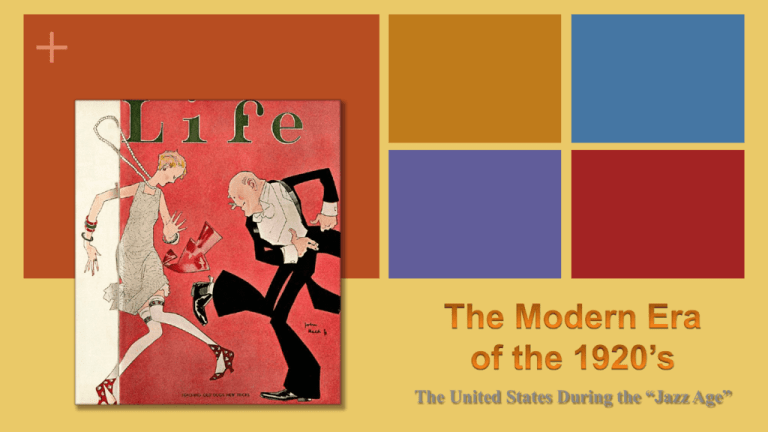
+ The United States During the “Jazz Age” + Themes of the “Roaring Twenties” Social Political Economic • Fundamentalism vs. Modernity • Advent of Mass Culture • Isolationism • Limited Government • Consumerism • Unrestricted and Uncontrolled Expansion + Essential Questions The 1920’s were a period of new and changing attitudes on the one hand and traditional values and nostalgia on the other. What led to this tension between old and new AND in what ways was the tension manifested? To what extent was American foreign policy during the 1920’s a continuation of past policy and to what extent was it a departure? + Politics: Republican Control Business Doctrine Calvin Coolidge: “The business of America is business” Weakening of Regulatory Agencies Business friendly administrations and Congress Sympathetic courts + The Harding Administration A “Return to Normalcy” The “Ohio Gang” A Few Good Choices Hughes (Sec. State), Hoover (Commerce), Mellon (Treasury), Taft (SCOTUS) Domestic Policy Reduced Income Tax Increased Tariff (FordneyMcCumber, 1922) Bureau of the Budget Pardoned Debs + The Downfall A Few Bad Choices Albert B. Fall (Interior), Harry Daugherty (Attorney General) Scandals Bribery (Daugherty) Teapot Dome (Fall) Death (August, 1923) + The Presidency of Calvin Coolidge “Silent Cal” The Election of 1924 Coolidge (R) vs. Davis (D) vs. LaFollette (Progressive) Vetoes and Inaction Cut spending Vetoes: Bonuses for WWI Vets McNary-Haugen (1928) + The Election of 1928 Herbert Hoover (R) Alfred E. Smith (D, NY) Administrative roles under three previous presidents Catholic, wet Hoover’s Quote Upon Receiving the Republican Nomination (August 11, 1928): “We in America today are nearer to the final triumph over poverty than ever before in the history of any land... We have not yet reached the goal, but given a chance to go forward with the policies of the last eight years, and we shall soon with the help of God be in sight of the day when poverty will be banished from this nation.” + Effects of Government Policy and the Birth of a Consumer Culture + Economic Development Characteristics: Immediate Post-War Recession (1921) Lengthy Business Prosperity (1922-1928) High Standard of Living Low Unemployment (less than 4%) Increased wages for middle and working classes Although prosperity did not extend to farmers and the working poor Economic Disaster (1929) + Causes of Business Prosperity Increased Productivity Efficiency (Taylor) Mass Production & Assembly Line (Ford, 1914) Energy Technologies Petroleum Oil = 23% of energy Electricity (300% increase in use) Motors in factories, appliances in homes Government Policy Corporate tax cuts, subsidies, and lax enforcement of antitrust laws Tax cuts for the wealthy (“Trickle-down” – Mellon) Federal Reserve Policies + A Consumer Economy New Appliances The Automobile Refrigerators, vacuums, washing machines Industrial and Cultural Revolution Increasing Sales Advertising Buying on Credit Installment Plans + Impact of the Automobile Economic Affected Industries: Gas, Steel, Glass, Rubber, Roads & Travel Replaced railroads Social Independence for Women and Teens Shopping, travel, commuting Cultural Iconic Advent of the “Big Three” Ford, GM, Chrysler + Economic Problems Farm Problems Post War Problems Massive debt Although new technology increased production, issues with prices and loans not addressed Labor Problems Declining union membership Result of welfare capitalism and association of unions with socialism Ineffectiveness of strikes United Mine Workers (John L. Lewis) Conservative court injunctions + Social and Cultural Developments of the “Jazz Age” + Causes Consumer Culture • Advertising • Mass Consumption New Technology Entertainment • Electricity • Radio & Automobile • Sports & Film • Arts and Literature + Entertainment The Radio (1920) National Syndication NBC (1924) CBS (1927) Promoted Uniformity and Advertising Hollywood “Talkies” (Jazz Singer, 1927) “Movie Stars” Chaplin, Garbo, Valentino Movie “Palaces” 80 million tickets weekly Popular Heroes Sports: Dempsey, Ruth, Thorpe, Jones Aviation: Lindbergh, Earhart + Gender Roles, Family, and Education Women at Home Gender roles reinforced New appliances didn’t change role of homemaker Women in the Labor Force Following war, went back to largely clerical jobs Receiving lower wages than male counterparts Revolution in Morals Psychology (Freud) Old vs. New Music, movies, fashion, smoking, sex Birth Control The “Flapper” Marriage and Divorce Rates Education Importance of schooling (high school: 25%) Path toward assimilation for immigrants + The Arts Literature The “Lost Generation” American expatriates protesting mass culture/cosumerism Poets: T.S. Eliot, e.e. cummings, Ezra Pound Writers: F. Scott Fitzgerald, Ernest Hemingway, Sinclair Lewis Examples: The Great Gatsby (Fitzgerald); Babbitt and Main Street (Lewis) Art & Architecture Art Deco Artists: Hopper, Wood, Benton Musical Theater Rhapsody in Blue and Porgy and Bess (Gershwin) + The Harlem Renaissance Migration of Jazz South (New Orleans) Up the River (St. Louis & Chicago) To the City (New York) Poets and Musicians Countee Cullen, Claude McKay, Langston Hughes, Zora Neale Hurston Duke Ellington, Louis Armstrong, Bessie Smith, Billie Holiday United Negro Improvement Association (1916) Marcus Garvey’s “Back to Africa Movement” + Values in Conflict Religion Modernism vs. Fundamentalism Manifestations: Revivalists Billy Sunday, Aimee Semple McPherson The Scopes “Monkey” Trial (Dayton, TN - 1925) Evolution on Trial Clarence Darrow vs. WJB + Views of the Scopes Trial + Prohibition 18th Amendment (1919) Volstead Act Defying the Law Bootleggers and Speakeasies Organized Crime Al Capone Alcohol Consumption actually increased in cities during Prohibition Political Discord and Repeal “Noble Experiment” created more problems than it solved Decline in overall alcoholism and alcohol-related deaths Increased criminal activity and other vices: prostitution, gambling, narcotics st 21 Amendment (1933) + Nativism Government Policies Emergency Quota Act (1921) 3% of 1910 Census 1924 Immigration Act 2% of 1890 National Origins Act Sacco and Vanzetti (1921) Sentenced to death Rebirth of the KKK Birth of a Nation (D.W. Griffith, 1915) Over 5 million members by 1925 Tactics: Targeted “Un-Americans” Violence and threats Political influence Decline: Fraud, corruption, and vice + The Fiction of Isolation and the Emergence of a World Power + Disarmament and Peace Washington Conference (1921) Five-Power Treaty 5:5:3:1.67:1.67 Four-Power Treaty US, France, Great Britain, and Japan Nine-Power Treaty Respect Open Door Policy in China Kellogg-Briand Pact (1928) Renounced use of force to achieve national ends Ineffective: permitted defensive wars and failed to provide enforcement + Business and Diplomacy Latin America Morrow negotiates for US oil investors in Mexico (1927) Troops sent to Nicaragua and Haiti, pulled from the Dominican Republic (1924) US investments double from 1919-1929 Middle East Hughes negotiates for oil-drilling rights Tariff Policy 25% (Fordney-McCumber) European nations retaliate with own tariffs War Debts and Reparations Dawes Plan + Legacy of the “Roaring Twenties” New Technology and advances in the arts & entertainment lead to birth of a mass culture. Xenophobia and disillusionment with war leads to nativism and isolation. Consumerism and advertising, coupled with lax government regulation leads to economic boom (albeit mainly false growth). + Understanding the 1920’s by using the Streets of New York: Entertainment Shopping Advertising Finance
